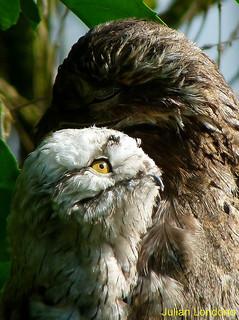Last week’s Mystery Creature was the Potoo, in this case the Common Potoo (Nyctibius griseus). Here are some interesting facts about this very unusual bird:
Potoos can be found in Central and South America, although fossil finds dating back to the Oligocene and Eocene suggest ancestors of these birds were once also found in France and Germany.
Potoos make some very unusual sounds. As thy need to communicate through a vast habitat they need a noise that can travel. Each species makes a unique call: The common Potoo, for example makes a series of mournful whistle type noises that deepen with each call. Legend has it that this sound is a mournful lament for a lost love – the moon.
Potoos are nocturnal animals. As they spend their days perched on trees and branch stumps they need some effective camouflage. Their elaborate plumage helps them blend in with their arboreal surroundings. Once the Potoo is perched it is very hard to spot as blends into the bark of the tree or takes on the appearance of a branch stump.

Potoos usually mate for life.
Potoos do not build nests; instead they will lay a single, spotted egg in the stump of a branch or appropriate nook on a tree.
Both parents will guard the egg and tend to the hatchling.
Potoos have small beaks but very broad mouths, helpful for catching insects such as moths and beetles while in flight.
An interesting feature of the Potoo is that it can still see even when it closes its eyes… a useful feature when relying on camouflage for protection. Their eye lids have little kinks to allow them a discrete peep-hole view of their surroundings.
In this short video clip Sir David Attenborough gets up close with one of these elusive birds.